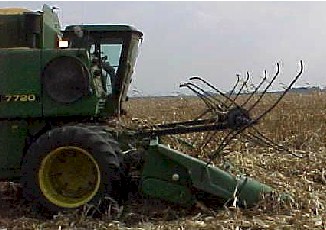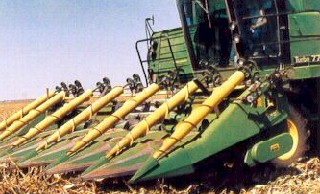Lodging in Corn
Originally written February 1, 2006 | Last updated September 6, 2018
As farmers start harvesting earlier planted corn fields (those typically
planted in mid May or earlier), they often encountered stalk lodging
especially in fields that received little or no rain. For a corn plant
to remain healthy and free of stalk rot, the plant must produce enough
carbohydrates by photosynthesis to keep root cells and pith cells in the
stalk alive and enough to meet demands for grain fill.
When corn is
subjected to stress during grainfill, photosynthetic activity is
reduced. As a result, the carbohydrate levels available for the
developing ear are insufficient. The corn plant responds to this
situation by removing carbohydrates from the leaves, stalk, and roots to
the developing ear. While this "cannibalization" process ensures a
supply of carbohydrates for the developing ear, the removal of
carbohydrates results in premature death of pith cells in the stalk and
root tissues, which predisposes plants to root and stalk infection by
fungi. As plants near maturity, this removal of nutrients from the stalk
to the developing grain results in a rapid deterioration of the lower
portion of corn plants in drought stressed fields with lower leaves
appearing to be nitrogen stressed, brown, and/or dead.
Other plant stresses which increase the likelihood of stalk rot problems
include: loss of leaf tissue due to foliar diseases (such as gray leaf
spot or northern corn leaf blight), insects, or hail; injury to the root
system by insects or chemicals; high levels of nitrogen in relation to
potassium; compacted or saturated soils restricting root growth; and
high plant populations.
Most hybrids do not begin to show stalk rot symptoms until shortly
before physiological maturity. It is difficult to distinguish between
stalk rots caused by different fungi because two or more fungi may be
involved. Similarly, certain insects such as European corn borer often
act in concert with fungal pathogens to cause stalk rot.
The presence of stalk rots in corn may not always result in stalk
lodging, especially if the affected crop is harvest promptly. It's not
uncommon to walk corn fields where nearly every plant is upright yet
nearly every plant is also showing stalk rot symptoms. Many hybrids have
excellent rind strength, which contributes to plant standability even
when the internal plant tissue has rotted or started to rot. However,
strong rinds will not prevent lodging if harvest is delayed and the crop
is subjected to weathering, e.g. strong winds and heavy rains.
A symptom common to all stalk rots is the deterioration of the inner
stalk tissues so that one or more of the inner nodes can easily be
compressed when squeezing the stalk between thumb and finger. It is
possible by using this squeeze test to assess potential
lodging if harvesting is not done promptly. The push test is another way to
predict lodging. Push the stalks at the ear level, 6-8" from the
vertical. If the stalk breaks between the ear and the lowest node, stalk
rot is usually present.
To minimize losses for stalk lodging rot damage, avoid harvest delays.
Identify fields that are at greatest risk and harvest these fields
first. Fields which experienced late season stress or extensive
disease would be prime candidates for
early harvest.
- Safety first
- Reduce ground speed. Slow down and adjust gathering chain and snapping roll speed to match combine speed
- Go against the grain. Combine corn the opposite direction from which it leans.
- Catch the corn. Adjust gathering chains and snapping plate as close as possible to the stalks.
- Reach down low. Run the head as close to the ground as possible. Be wary of rocks and uneven terrain.
-
Be ready. Scout fields to anticipate harvest problems.
Specialized Equipment for Down Corn



Heritage Machine & Welding
1001 W. Locust
Bloomington, IL 61701
(800) 274-0440
www.hmwinet.com
|
Corn Reel by Minden Machine Shop Inc.
1302 K Road
Minden, NE 68959
(800) 264-6587
|
The Meteer Corn Reel
Meteer Manufacturing
RR1 Box 221
Athens, IL 62613
(217) 636-8109
www.meteer.com
|
The Roll-A-Cone
Roll-A-Cone Manufacturing
7655 Roll-A-Cone Road
Tulia, TX 79088
(806) 668-4722
www.roll-a-cone.com
|
Hawkins Corn Reel
Hawkins Manufacturing, Inc.
2120 4th Ave
Holdrege, NE 68949
800-382-6178
www.hawkinsmfg.com
|
|
Marion Calmer's Recommendations for Harvesting Down Corn
- Install auto header height on your corn head.
- Flatten the corn head angle.
- If the corn is lodged "with the row" steepen the corn head angle.
- Synchronize gathering chain speed to ground speed.
- Set the clearance between the tray and cross auger flighting at two inches for down corn.
- Open stripper plates.
- Use more taper from bottom to top on stripper plates.
- Center the stripping tunnel above the stalk roll tunnel.
- Synchronize gathering chain lugs to be opposed from one another.
- Attach metal paddles onto every other gathering chain lug to increase the conveying capacity of chain.
- Install a corn reel.
- Take off any end risers or tall corn extensions.
- Remove rubber ear savers.
- Add weight to poly divider snouts to help them stay under the canopy.
- Grind the wear shoe tips of the dividers or shim to give more pitch to help them stay under the canopy.
- Use stalk rolls with revolving windows.
- Start harvesting on the downwind side of the field.
- Turn gathering chains around to increase aggressiveness.
Further Reading
Carter, P.R. 2015. Wind Lodging Effects on Corn Growth and Grain Yield.
Pioneer Insights, see
https://www.pioneer.com/home/site/us/agronomy/library/wind-lodging-effects/.
Carter, P.R., and K.D. Hudelson. 1988.
Influence of simulated wind lodging on corn growth and grain yield. J.
Prod. Agric. 1:295-299.
Nielsen, B., and D. Colville. 1988.
Stalk
Lodging in Corn: Guidelines for Preventive Management. Agronomy Guide,
AY-262 Purdue University, West Lafayette, IN